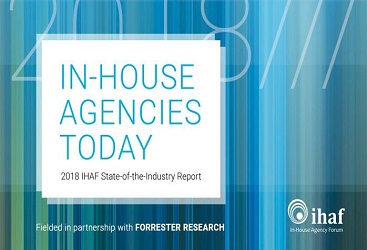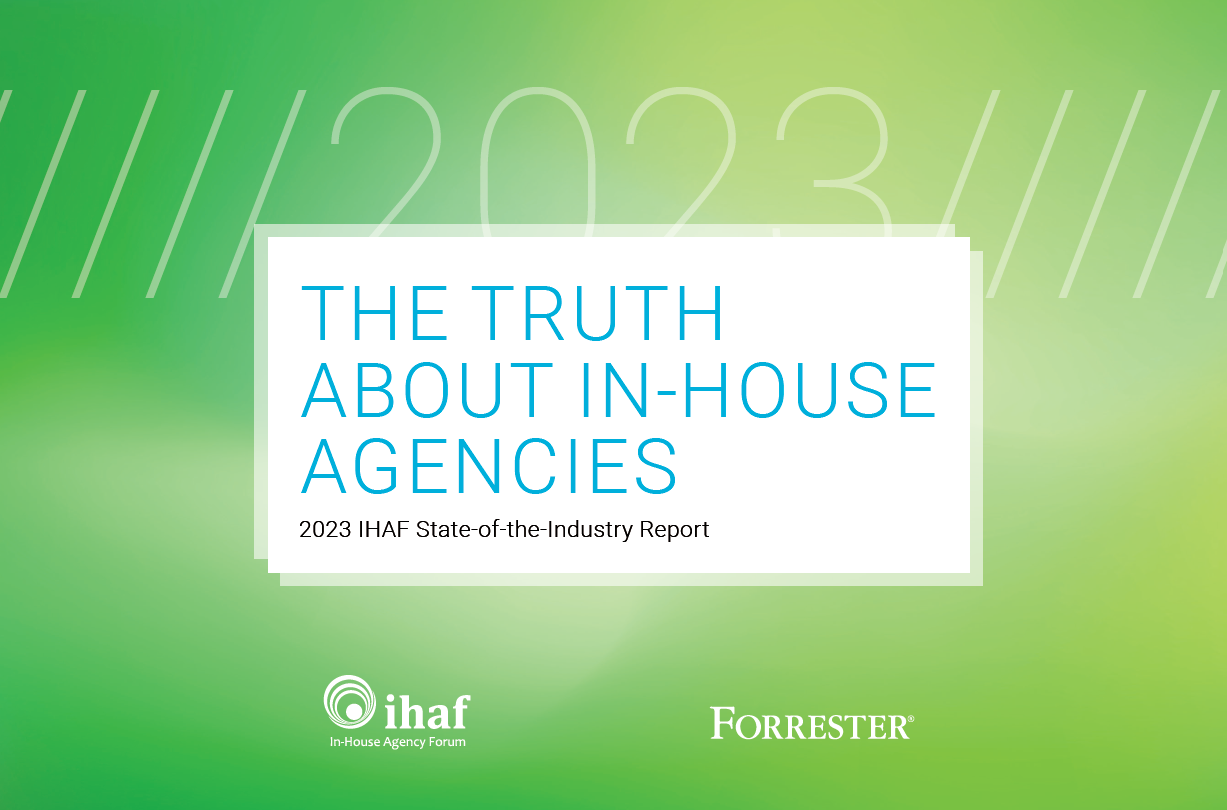Internal Agencies Are On the Rise

IHAF recently revealed top trends and business challenges among in-house agencies in its 2018 benchmarking study, fielded in partnership with Forrester Research and featured in the Wall Street Journal. The report details the functional competencies, service offerings, project composition and operating practices of today’s internal agencies—with added perspective from external agencies and client-side marketers.
According to the results, the penetration of in-house agencies has increased by 52% in the past decade—with more and more corporations investing in the development and expansion of internal advertising and creative teams. Deep knowledge of both the business and the brand emerged as the leading advantages of the in-house agency model with internal and external agencies reportedly viewing each other more as a complement than a threat.
Over 300 companies participated in the study, with industries ranging from financial services to insurance, healthcare to hospitality and manufacturing to retail. Respondents included in-house agency leaders, client-side marketers, external agencies and vendor partners.
In addition to revealing that the penetration of internal agencies has increased from 42% in 2008 to 64% today, IHAF’s 2018 study details notable growth in the size of in-house teams. Fifty-five percent of companies with an internal agency invested in additional headcount over the past two years, with half employing corporate creative teams of 25 employees or more.
Despite expanding team sizes, 67% of in-house agencies indicated that they are not adequately staffed to meet the demands of the business, with the majority stipulating that they do not have enough people to respond to the rising influx of projects. Our study ranked recruitment of talent and staying abreast of industry trends as leading disadvantages of the in-house model, with corporate marketers citing digital know-how and creative expertise as lacking.
Historically, in-house agencies have been lauded for the cost and time saving they deliver to their parent companies. In fact, when IHAF partnered with the Association of National Advertising (ANA) on a similar study in 2008, the top two benefits of the in-house model were cost efficiencies and quicker turnarounds. Today, cost and time are ranked third and fourth respectively, behind brand and business acumen, indicating that in-house agencies are not only expected to deliver demonstrable value and efficiency to their parent companies, they are expected to operate with a high degree of strategic firepower. The challenge comes in keeping overhead low while advancing the talent required of today’s in-house teams.
“Talent is a critical component of the performance of any agency, regardless of its organizational form,” says leading expert and industry consultant, Marta Stiglin. “The challenge today’s in-house agencies face is being saddled with this insatiable appetite for saving while simultaneously being asked to impact the business at a much higher level. To evolve internal agencies that have mastery of the business, command of the brand and a high degree of digital and creative prowess, C-suite executives need to stop looking at the in-house model as a way to save and start looking at it as a corporate strategy.”
Jay Pattisall, lead analyst at Forrester Research, agrees, “IHAF’s 2018 State-of-the-Industry Report clearly defines the opportunity for CMOs to invest in in-house talent and resources. The fact that 41% of marketers perceive internal agency teams as lacking in digital know-how is a rallying cry for the in-house imperative.”
One of the ways in-house agencies are augmenting their teams to not only respond to increased volumes of work but to galvanize talent is by partnering with external agencies and third-party providers. In fact, our report shows that 85% of today’s in-house agencies outsource some portion of their project load to external resources. This finding is significant, particularly given that previous studies noting the growth of the in-house model triggered fear of potential disintermediation of traditional agencies.
Nearly half of the internal and external agencies we polled in 2018 indicated that the two agency types are complementary, despite long-standing generalizations that in-house agencies are a threat to externals. In fact, only 30 percent of external agencies who responded to the IHAF survey perceive the advancement of the in-house model as a threat. As Forrester’s Jay Pattisall concludes, “Teams of internal specialists blended with external specialists are the future of agency sourcing and the ideal model to optimize the mix of talent and enable collaboration.”
Our full 2018 State-of-the-Industry Report, In-House Agencies Today, is available for IHAF members to download. If you are not a member of IHAF and would like to purchase a copy of the report, please contact us.
- advertising,
- agency,
- ANA,
- association,
- benchmarking,
- brand,
- client,
- CMO,
- content,
- corporate,
- creative,
- data,
- digital,
- efficiency,
- executive,
- external,
- forrester,
- IHAF,
- in-house,
- insource,
- internal,
- leadership,
- management,
- marketing,
- media,
- membership,
- model,
- pattisall,
- process,
- professional,
- report,
- research,
- savings,
- social,
- state of the industry,
- stiglin,
- study,
- survey,
- talent,
- trends,
- value
Recent Posts

In-House Data: Fact or Fiction?
October 16, 2023
I’m going to be honest with you, which I always am but this time it’s scary honesty. There are a lot of in-house agency research reports out there. And not all of them contain data that are close to the integrity of the studies IHAF publishes—the next of which drops at the IHAF conference on …

IHAF Wrapped
December 20, 2023
One of our favorite things to do at year-end is look back at the events, presentations, and online resources our members tapped most. (Why should Spotify have all the fun?) Here are a few of your favorites in 2023:
• New Assortment of Org Charts Download • Updated Job Profiles …



















%20(1).pdf%20-%20Copy.jpg)

%20(1).png)


No Reader Comments